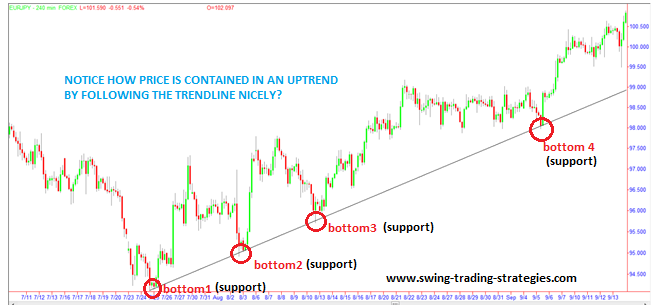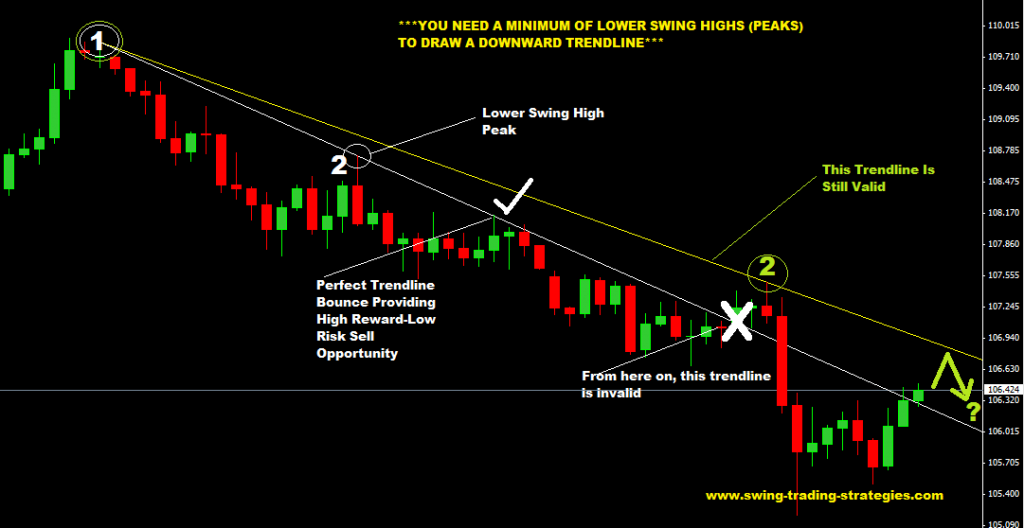
Trend lines are a great way to frame the market movement and often times they seem to act as support and resistance.
Keep in mind it is not the actual trend line that stops price but can pinpoint areas on the chart where trader may have an interest in taking a position.
You will often find that when you draw a trend line and price comes down to it, other price structures are also in the area (look left on the chart) that can add confluence to your trading setup.
It is very easy to be overly subjective when searching for trend lines so it is important that you determine your method to draw them and then to be consistent
Without being consistent, you will never know if you are taking full advantage of the potential of your trading system.
What Does a Correctly Drawn Trend Line Show You
When you draw a trend line, it can quickly give you 3 things that can aid you in your trading:
- Trend Direction
- Potential Market Swing Points
- Clarity Without Trading Indicators
Trend Direction
While some traders (most) will use moving averages to determine trend direction, a correctly drawn trend line will show you the overall direction of the market. When a trend line breaks, it can give you a “heads up” of a potential change in trend direction.
Potential Market Swing Points
Price moves in waves with peaks and troughs. Trend lines can highlight areas on your chart where the next turn in price can occur especially in the dominant trend direction.
Clarity
Far too many traders use too many trading indicator on their trading chart. They have duplicate information (some traders will use 2 or more momentum indicators for example) and all that does is lead to confusion and anlysis paralysis. Trend lines keep it simple and will not hide the most important part of any chart: price.
3 Steps To Drawing An Up Trend Line
An uptrend line indicates a market in an uptrend. That is unless you are using a trend line on a micro structure such as a pullback in price. Why do we draw the trend line?
There are two main purposes for me for drawing upward trend lines:
- To trade off the upward bounce of the upward trend line
- See if price intersects that upward trend line, it is a potential signal for a downtrend so if I have trade positions are currently in profit, I should be probably thinking of bailing out!
Referring to the chart above…
- Look for higher swing lows or call it “bottoms” of price if you may.
- For a market in an uptrend (like the chart above), trend lines must be drawn below the price connecting a minimum of 2 bottoms of increasing height. You need a minimum of 2 bottoms to draw a trend line.
- Make sure the bottoms are spaced apart nicely. If they are close together, it is generally not good to use. If they are too far apart, they would not be noticeable.
3 Steps To Drawing A Down Trend Line
- Look for lower swing highs or call it “peaks” of price if you may.
- For a downtrend market (like the chart below), trend lines must be drawn above the price connecting a minimum of 2 peaks of decreasing height. You need a minimum of 2 peaks to draw a trend line.
- Make sure the peaks are spaced apart nicely. If they are close together, it is generally not good to use. If they are too far apart, they would not be noticeable.
Tips For Drawing Trend Lines
A trend line is just a straight line on your chart. It has no magical properties but they do a great job of highlight price movement (rhythm).
Higher Time Frame
As with most price action and technical analysis methods, higher time frame trading charts seem to respond better. Lower time frame charts have a lot of “random movements” and just like a chart pattern trader, you want to look at meaningful price movements. What is more meaningful than something like a daily chart? It highlights the overall condition of that instrument without getting bogged down in every blip on the screen. You will also be able to better spot the long term trend.
Support Levels and Resistance Levels
As mentioned, trend lines do not contain price like a barrier. They do show the rhythm and momentum of the market (think of fanning trend lines) and many traders do use them. Are they a self fulfilling prophecy? I don’t know but they do seem to represent turning points and often line up with price structure which is as close to the market as you can really get.
Don’t Squint
When drawing a trend line, there is no true correct way. There are methods such as Demark Trend lines or using how Victor Sperandeo draws them but the key point is if the swings don’t pop out at you, you are just guessing. Best fit is a good motto to use.
Don’t Place Stops Directly Above Or Below
They are not a brick wall and many times price will flash below the trend line after you placed a trade. Since the common method of stop placement is right below the trend line (or horizontal support and resistance level), they are ripe for stop hunts as traders seek order flow. Use an ATR type of stop loss placement so you don’t get taken out when the masses do and let their re-entry propel your trade in your direction.
Use Trend Lines To Form A Price Channel
To frame price even better, consider drawing a trend line, copying it, and then placing it on the opposing side of price (highs or lows). Price generally channels, drives, channels, drives…and a trend line channel can help you visualize that type of price behavior.






 Posted in
Posted in  Tags:
Tags: